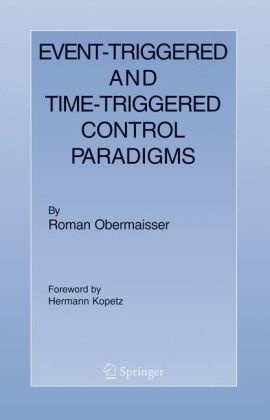En savoir plus
Event-Triggered and Time-Triggered Control Paradigms presents a valuable survey about existing architectures for safety-critical applications and discusses the issues that must be considered when moving from a federated to an integrated architecture. The book focuses on one key topic - the amalgamation of the event-triggered and the time-triggered control paradigm into a coherent integrated architecture. The architecture provides for the integration of independent distributed application subsystems by introducing multi-criticality nodes and virtual networks of known temporal properties. The feasibility and the tangible advantages of this new architecture are demonstrated with practical examples taken from the automotive industry.
Event-Triggered and Time-Triggered Control Paradigms offers significant insights into the architecture and design of integrated embedded systems, both at the conceptual and at the practical level.
Table des matières
Foreword
Preface
1: INTRODUCTION
1.1 Goal of this book
1.2 Overview
2: BASIC CONCEPTS AND RELATED WORK
2.1 Distributed Real-Time Systems
2.2 Concepts of Dependability
2.3 Degrees of Synchrony
2.4 Communication System Paradigms
2.5 Computational Models
2.6 System Architectures
3: REQUIREMENTS OF AN INTEGRATED ARCHITECTURE
3.1 Integration Directions
3.2 Required Properties
3.3 Generic Architectural Services
4: INTEGRATION OF EVENT-TRIGGERED AND TIME-TRIGGERED CONTROL PARADIGMS
4.1 Synchrony Model
4.2 Architecture
4.3 Component Level
4.4 Dependability Mechanisms
4.5 Membership Information
5.CAN EMULATION IN THE TTA
5.1 The Time-Triggered Architecture
5.2 Controller Area Network
5.3 Requirements and Objectives
5.4 CAN Communication Services in the TTA
5.5 Implementation
6: RESULTS AND VALIDATION
6.1 Validation Objectives
6.2 Transmission Latencies
6.3 Input Message Sets
6.4 Simulations and Measurements
6.5 Authentic CAN Communication Service
6.6 Extended CAN Communication Service
6.7 Solving of Dependability Problems of the CAN Protocol
7: CONCLUSION
References
Index
Résumé
Event-Triggered and Time-Triggered Control Paradigms presents a valuable survey about existing architectures for safety-critical applications and discusses the issues that must be considered when moving from a federated to an integrated architecture. The book focuses on one key topic - the amalgamation of the event-triggered and the time-triggered control paradigm into a coherent integrated architecture. The architecture provides for the integration of independent distributed application subsystems by introducing multi-criticality nodes and virtual networks of known temporal properties. The feasibility and the tangible advantages of this new architecture are demonstrated with practical examples taken from the automotive industry.
Event-Triggered and Time-Triggered Control Paradigms offers significant insights into the architecture and design of integrated embedded systems, both at the conceptual and at the practical level.

